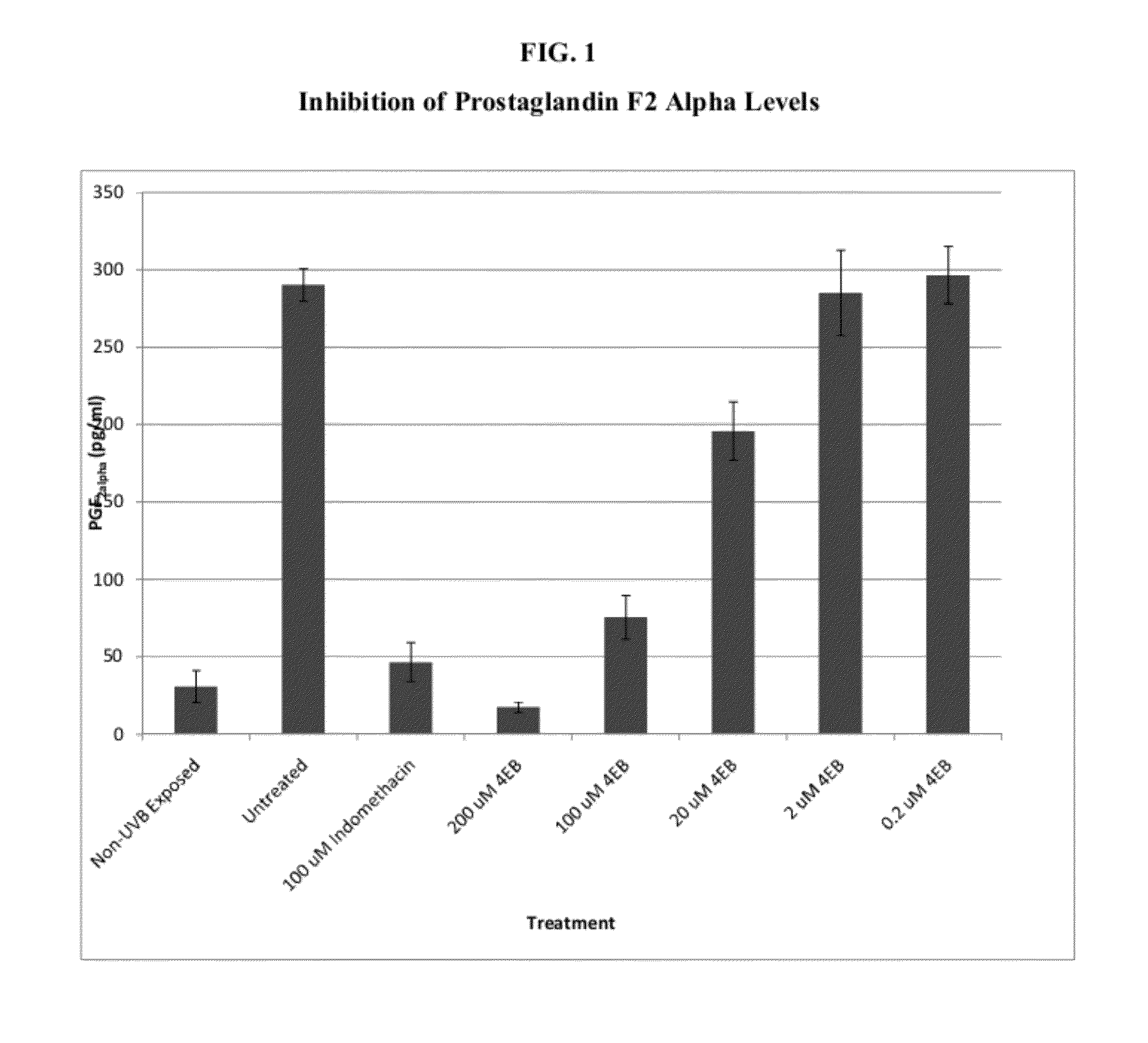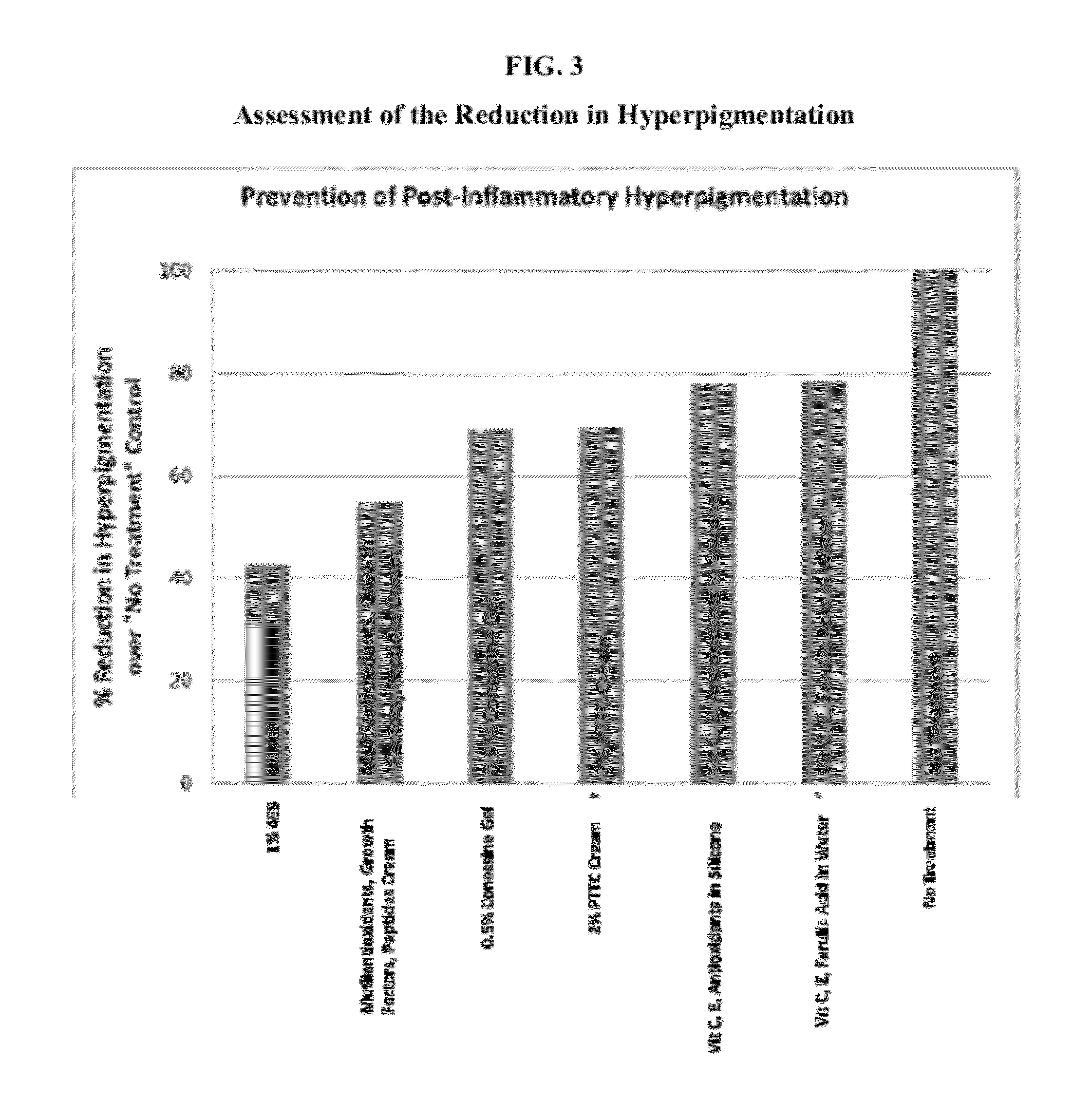Melanin modification compositions and methods of use
a technology of melanin and composition, applied in the field of melanin modification compositions and methods of use, can solve problems such as significant psychosocial distress, and achieve the effect of reducing melanin distribution and lightening skin
- Summary
- Abstract
- Description
- Claims
- Application Information
AI Technical Summary
Benefits of technology
Problems solved by technology
Method used
Image
Examples
example 1
Inhibition of Prostaglandin F2 Alpha Levels
[0339]Human keratinocytes were harvested and exposed to with UVB light to induce PGF2 alpha release. Following exposure to UVB irradiation, the cells were treated with a composition comprising 1% 4-ethoxybenzaldehyde, Indomethacin (positive control) or left untreated (negative control). After 24 hours post-treatment, PGF2 alpha levels were measured by ELISA analysis. The composition comprising 4-ethoxybenzaldehyde provided dose-dependent inhibition of PGF2 alpha in UVB-induced cells (FIG. 1).
example 2
Skin Tone Clinical Study
[0340]Approximately 30 healthy subjects, aged 20-64 years with Fitzpatrick Skin Types I-III, are enrolled in this single-center, double-blinded comparison study. Assignments of the test product or vehicle to subjects are randomized 2:1 to avoid bias. A total of approximately 15 subjects receive the test product and 15 subjects receive the vehicle. Subjects follow a twice-daily product application regiment for 4 weeks. No other moisturizers, lotions or products are allowed to be applied during the study. At the baseline visit, subjects are graded by a dermatologist for uneven skin tone on their facial skin. Standardized digital photographs of the test site (i.e., face) are also taken. At the end of week 2, subjects are graded by a dermatologist for uneven skin tone on their facial skin. Standardized digital photographs of the test site (i.e., face) are also taken. Twice-daily application of test product continues for another 14 days. At the end of 4 weeks, sub...
example 3
Post-Inflammatory Hyperpigmentation Clinical Study
[0341]UV irradiation stimulates a variety of biochemical pathways in the skin, resulting in free radical formation as well as the release of inflammatory mediators. The short-term clinical effects observed from these pathways, include cutaneous inflammation and erythema, while long-term effects (for example, in the absence of treatment of the inflammatory response) result in photodamaged skin. UV irradiation may also cause the development of post-inflammatory hyperpigmentation since it induces an inflammatory response in the skin that can proceed to hyperpigmentation.
[0342]The 17 healthy female subjects, aged 26-63 years with Fitzpatrick Skin Types III-IV, were enrolled and completed this single-center, double-blinded comparison study. At baseline, test areas were marked onto the backs of the subjects: Untreated control, 1% w 4EB composition, antioxidant product, and other test products. Assignments of the test products to test areas...
PUM
| Property | Measurement | Unit |
|---|---|---|
| wavelength region | aaaaa | aaaaa |
| wavelength region | aaaaa | aaaaa |
| weight percent | aaaaa | aaaaa |
Abstract
Description
Claims
Application Information
 Login to View More
Login to View More - R&D
- Intellectual Property
- Life Sciences
- Materials
- Tech Scout
- Unparalleled Data Quality
- Higher Quality Content
- 60% Fewer Hallucinations
Browse by: Latest US Patents, China's latest patents, Technical Efficacy Thesaurus, Application Domain, Technology Topic, Popular Technical Reports.
© 2025 PatSnap. All rights reserved.Legal|Privacy policy|Modern Slavery Act Transparency Statement|Sitemap|About US| Contact US: help@patsnap.com



